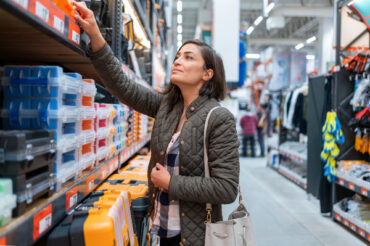Are in-store and ecommerce experiences aligned
January 15, 2020DAYS before U.S. Thanksgiving, Sandra Duff got a call from Aritzia. As a valued customer, she had earned early access to Black Friday sales. She just had to log onto her account and sign up for promotions and could find deals online or in store. The call came from store level, but it didn’t matter where Duff shopped.
“It was totally unexpected, and I felt special,” says Duff, SVP, Activation and Operations at Jackman, a retail strategy consulting firm.
Contrast that with Nith Nadarajah’s experience. Last summer, Nadarajah, Founder and CEO of Helios Retail Consulting, was looking for a big-ticket item online (at a major retailer to be unnamed). He ordered it, and a few hours later got an email saying it was ready for pickup. So Nadarajah hitched his trailer to his car and headed to the store.
When he inquired, a sales associate disappeared for 20 minutes. The product couldn’t be located. The manager joined in and walked the entire store. No sign of the item. By now an hour had passed. Finally, the item was found, but couldn’t be released. It lacked a pre-delivery inspection, something neither the online nor in-store teams had flagged.
Nadarajah left and cancelled the purchase. “This isn’t the kind of process you want,” he says. “I won’t do ‘buy online, pick up in store’ there anymore.”
As consumers, Duff was thrilled and Nadarajah was frustrated. As industry consultants, they also understand the challenges any merchant faces. How can retailers connect the in-store experience with eCommerce to drive growth on both channels? What are some principles behind this strategy, and what must be in place to make it work?
To explore the issues, we talked to Nadarajah; Duff; her colleague Keefe Lee, VP, Digital Activation at Jackman; and John Torella, marketing advisor at J.C. Williams Group, a retail and marketing consulting firm.
Nadarajah focuses on strategy and technology implementations. Before Helios, he
held senior roles at Walmart, Loblaws and Deloitte Canada. Duff has built
branded customer experiences across channels, and prior to Jackman led
integrated marketing for a grocery chain. Lee has experience across retail and
CPG. And Torella has worked with some of the world’s top brands and written
four books on retail branding and marketing.
HOW DO IN-STORE AND ONLINE TEAMS TEND TO VIEW EACH OTHER?
Torella: It’s hard to generalize, but sometimes there’s real conflicts. That comes out of not being aligned. Those that get it, there’s a real sense they’re a team, and integration on everything they do—particularly the seamless experience online and in store.
Duff: I don’t think at the store level the associates even think of the digital team or the digital experience of the customer.
IS THERE FINANCIAL COMPETITION BETWEEN IN-STORE AND ONLINE TEAMS? IS THAT HEALTHY?
Nadarajah: There’s a certain level of cannibalism. When you’re buying online and picking up in store, you’re taking inventory from the store. The store is paying for the resource to pick that thing off the shelf, but the sale is attributed to online. Store management might feel they need to schedule extra people and budget for this. They’re not getting the ROI, but they are getting KPI on it, like if they’re running behind schedule. It’s like taxation without representation.
THERE ISN,T A THOUGHT OF BEING ONE BIG HAPPY RETAIL FAMILY?
Nadarajah: At the management level, there’s that view. But at the tactical level, it’s easy to forget the expectation that it’s one customer.
Duff: I haven’t seen competition as much as not being aligned. Ten years ago, there was a fear that online would steal sales. What I do see now are siloes.
Lee: At the end of the day, you have one customer, and the goal is to maximize your efficiency in getting that transaction. The right view to take is to put the customer first, rather than planning by channel, which is where some biases can come.
THE ONE CUSTOMER VIEW CAN FALL APART IN EXPERIENCES LIKE NITH,S, WITH THE BOTCHED IN-STORE PICKUP. WHERE DOES THE FAULT LIE?
Nadarajah: I don’t blame the store. I blame central operations or the management team. There’s an expectation on the consumer side to have seamless experience. But on the store side there’s also an expectation that bricks-and-clicks works seamlessly internally. The reason a manager might be prickly about buy online and pick up in store is because it’s not smooth for them. Head office has engineered a process but hasn’t refined it in way that seamless for the staff. They release it to public, and say they’ll work out the kinks later.
IS THAT A PROCESS ISSUE? A TECHNOLOGY ISSUE? A TRAINING ISSUE?
Nadarajah: It’s all these things. Retailers don’t map out the process 100%, or make sure there’s an understanding at store level, or make sure the technology is 100% stable. If data and processes aren’t aligned properly, you’re going to have problems.
TO STAY COMPETITIVE, THE MANTRA IS THAT RETAILERS MUST PROVIDE ENGAGING SHOPPING EXPERIENCES THAT ARE CONSISTENT ACROSS ALL CHANNELS. WHAT DOES THAT MEAN?
Duff: What does your brand stand for? How are you pushing out an experience or proposition that’s resonating with the customer, that’s satisfying what the customer is looking for? Consistency is tailoring according to the channel but having the core of what you stand for still there.
Torella: Break down the path to purchase in detail—the search, the buying experience, the delivery experience, the product in use experience—and try to get at the friction points for the consumer.
Nadarajah: It’s just buzzwords. If you’re going to engage people, you need
the ability to have information available to frontline staff that’s also
available online, all to help consumers make decisions.
DO IN-STORE TEAMS NEED TO BE INCENTIVIZED TO SHOWCASE AND EFFECTIVELY PROMOTE ONLINE INITIATIVES?
Torella: If people see the value, they just do it intuitively. If you have to incent them, there’s an issue.
Duff: If you’re a commissioned salesperson, this conversation’s more complicated. If you’re not commissioned, it just has to be part of the brand persona. You need to build that into your process.
Lee: If you have a great story to tell, your people will be champions.
IS THERE A DISCONNECT BETWEEN DATA COLLECTION ONLINE AND IN-STORE? IF SO,WHY?
Lee: Data should be a business function that exists within leadership teams. If you centralize transactional data and customer behaviour data, you can become smarter in how you talk to that customer and find more pockets of opportunity. You want centralized data and centralized measurement and analytics.
IN CREATING THE PILLARS OF A TRUE OMNICHANNEL STRATEGY, WHAT,S THE FIRST CHALLENGE?
Torella: Define the strategy. Then determine if you can deliver a compelling and competitive point of difference that’s meaningful to the customer. It might be a price strategy, or the broadest assortment, or a service strategy, or an experience strategy. The principles don’t change. But it’s interesting to see how often they’re ignored.
Duff: To me it’s having one view of the customer. The connective tissues between the teams is where there are gaps.
Nadarajah: The pillars are always people, processes and technology. They have to all work together to execute a seamless customer experience. You always want to keep the customer in the centre of your focus and make staff experiences as important as customer experiences.
CONSUMERS OFTEN WANT CONVENIENCE ONLINE AND MORE PERSONALIZATION IN THE STORE. BUT THE OPPOSITE CAN BE TRUE TOO. HOW HAS THE RISE OF ECOMMERCE ALTERED WHAT,S EXPECTED FROM THE IN-STORE EXPERIENCE?
Duff: People use the platforms differently. It’s more than just one simple equation.
Lee: Ecommerce has changed how people want brands to show up for them. You always find something you’re looking for. You know its available, and it’s there the next day. At retail sometimes, not knowing what’s on shelf causes more friction. So how can we bring an eCommerce-like experience into the physical space?
Nadarajah: We need a mind shift at the store level. Now, people are more order takers instead of thinking how to help customers get the most out of their visit.
AND IF IN-STORE SHOPPING PATTERNS ARE CHANGING BECAUSE OF ECOMMERCE?
Nadarajah: We need to empower people at the floor level to give a really good experience whether people are coming in for a minute or an hour. There’s a thought process that having more product data in the system will help solve customer service issues. But most problems in retail can be solved with intelligent process design, people and a lot more soft skills training.
WHAT,S NEEDED TO CONNECT THE PHYSICAL AND ONLINE?
Duff: A centralized chief customer officer. We want a robust understanding of the customer, and a unified view of the brand.
NO MATTER THE DELIVERY CHANNEL, WHAT,S THE KEY THING TO HAVE IN PLACE?
Torella: Enlightened and inspired leadership that recognizes the importance of alignment and puts the resources in place. If you do that, you start to get the end experience you’re aiming for.
BY STUART FOXMAN



